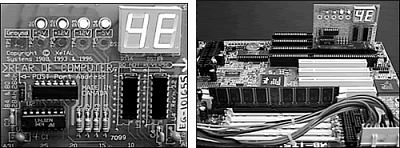BIOS Error Messages
When a PC system is first powered on, the system runs a POST. If errors are encountered during the POST, you usually see a text error message displayed onscreen. Errors that occur very early in the POST might happen before the video card is initialized.
These types of errors can't be displayed, so the system uses two other alternatives for communicating the error message. One is beeping—the system beeps the speaker in a specific pattern that indicates which error has occurred. The other alternative is to send a hexadecimal error code to I/O port address 80h, which can be read by a special card in one of the bus slots.
When the ROM BIOS is performing the POST, in most systems the results of these tests are continuously sent to I/O Port 80h so they can be monitored by special diagnostics cards called POST cards.

These tests sometimes are called manufacturing tests because they were designed into the system for testing systems on the assembly line without a video display attached.
The POST cards have a two-digit hexadecimal display used to report the number of the currently executing test routine. Before executing each test, a hexadecimal numeric code is sent to the port and then the test is run. If the test fails and locks up the machine, the hexadecimal code of the last test being executed remains on the card's display.
Many tests are executed in a system before the video display card is enabled, especially if the display is EGA or VGA. Therefore, many errors can occur that would lock up the system before the system could possibly display an error code through the video system.
Because not all these errors generate beep codes, to most normal troubleshooting procedures, a system with this type of problem (such as a memory failure in Bank 0) would appear completely "dead." By using one of the commercially available POST cards, however, you can often diagnose the problem.
These codes are completely BIOS dependent because the card does nothing but display the codes sent to it. Some BIOSs have more detailed POST procedures and therefore send more informative codes. POST cards can be purchased from JDR Microdevices or other sources and are available in both ISA and PCI bus versions.
For simple but otherwise fatal errors that can't be displayed onscreen, most of the BIOS versions also send audio codes that can be used to help diagnose such problems. The audio codes are similar to POST codes, but they are read by listening to the speaker beep rather than by using a special card.
General BIOS Boot Text Error Messages
During the boot process, the bootstrap loader routine in the motherboard ROM BIOS reads the first physical sector of each of the bootable drives or devices, which is cylinder 0, head 0, sector 1 in CHS mode or logical block address 0 in LBA mode.
The code from the first sector is loaded into RAM, and the last two bytes are checked to see whether they match a signature value of 55AAh. If the signature bytes match, that tells the ROM that the first sector contains a valid MBR and that the ROM can continue by transferring control to the MBR code.
If the last two bytes of the first physical sector do not match 55AAh, the ROM continues by checking the first physical sector of the next bootable device in the boot sequence until it either finds one with a valid MBR or runs out of devices to check.
If after checking all the drives or devices in the boot sequence, none are found to have the proper signature bytes indicating a valid MBR, the ROM invokes an interrupt 18h that calls a subroutine that displays an error message. The specific text or wording of the message varies according to the ROM manufacturer and version.